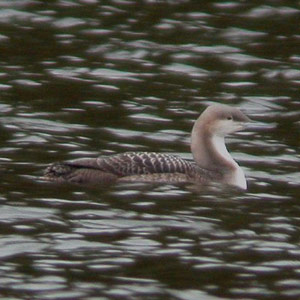Pratique | Identification
Observations de Plongeons du Pacifique au Royaume-Uni

Le « controversé » Plongeon du Pacifique (Gavia pacifica) juvénile du réservoir de Llys-y-Fran (Pays-de-Galles), février 2007.Photographie : M. Trott
Introduction
Observer pour la première fois une espèce dans le Paléarctique occidental est un événement : c’est ce qui est arrivé en janvier 2007 à June Atkinson , qui a découvert un juvénile de Plongeon du Pacifique (Gavia pacifica) sur les gravières de Farnham (Farneham) dans le Yorkshire. Un autre probable juvénile a ensuite été trouvé le 2 février sur le réservoir de Llys-y-Fran dans le Pembrokeshire, et enfin un adulte a été noté à Penzance (Cornouailles) le 17 février !
Cette série étonnante a « enflammé » la communauté ornithologique britannique, la distinction de cette espèce avec le Plongeon arctique (Gavia arctica) (qui étaient autrefois considérées comme deux sous-espèces d’une même espèce) étant souvent ardue.
Dans cet article, nous vous proposons des photos de ces trois oiseaux et nous revenons sur les critères d’identification : cela pourrait être utile, au cas où l’espèce serait vue un jour sur les côtes de l’Ouest de la France…
Abstract
Until recently thought to be a form of the Old World’s Arctic Loon (Gavia arctica), the Pacific Loon (Gavia pacifica) is well named, for nearly all of these birds winter along the Pacific Coast. It breeds on deep lakes in the tundra region of Alaska and northern Canada as far east as Baffin Island.
In January and February 2007, two certain Pacific Divers (Gavia pacifica) (+ one probable juvenile on Llys-y-Fran Reservoir, Pembrokeshire, the 2nd of February) were discovered in Great-Britain : a juvenile found mi-January on the Farnham (Farneham) Gravel Pits near Knaresborough (Yorkshire), and one adult off Penzance (Cornwall) the 17th February. The bird of Farnham was a first for western Europe. A fact which means that all the twitchers (more than 1,000 people) from across Britain (and Europe) will want to « tick » the bird. Because of the rarity of the bird and because it is on private land, a charge of £10 is apparently being made for parking and to access the bird…The bird was first seen by June Atkinson and confirmed by the Harrogate and District Naturalists’ Society.
The identification of juveniles and internuptial Pacific Divers can be difficult, depending of the conditions, as the species is very closed to the Arctic Diver (Gavia arctica), once considered as two sub-species of Gavia arctica species.
We propose you some photos of the three « British » birds, and all the useful criteria in the field.
Poursuivez la lecture de cet article, en vous abonnant dès maintenant !
Découvrez les Archives d’Ornithomedia.com
Pour seulement 10,00 €TTC/an (ou 6,00 € les 6 mois)
Profitez de plusieurs centaines d’articles en accès illimité et sans aucun engagement.
Compléments
À lire aussi sur Ornithomedia.com
- Identifier les quatre plongeons « européens » en hiver
- Les plongeons les plus observés des Etats-Unis
À lire sur le web
- Le site web de Matthew Sallis : www.nature-photos.biz
- Le site web de Steve Valentine : steve-valentine.fotopic.net
- Le blog de Craig Shawn : craigsbirdphotos.bravehost.com
Ouvrages recommandés
- Albatrosses, Petrels and Shearwaters of the World de Derek Onley (Auteur), Paul Scofield (Auteur)
- Flight Identification of European Seabirds de Anders Blomdahl, Bertil Breife et Niklas Holmstrom (31 mai 2007)





Aucun commentaire sur ce sujet
Participer à la discussion !